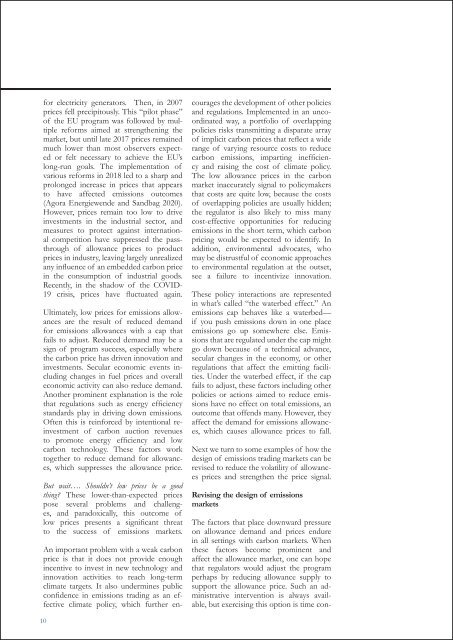You also want an ePaper? Increase the reach of your titles
YUMPU automatically turns print PDFs into web optimized ePapers that Google loves.
for electricity generators. Then, in 2007<br />
prices fell precipitously. This “pilot phase”<br />
of the EU program was followed by multiple<br />
reforms aimed at strengthening the<br />
market, but until late 2017 prices remained<br />
much lower than most observers expected<br />
or felt necessary to achieve the EU’s<br />
long-run goals. The implementation of<br />
various reforms in 2018 led to a sharp and<br />
prolonged increase in prices that appears<br />
to have affected emissions outcomes<br />
(Agora Energiewende and Sandbag <strong>2020</strong>).<br />
However, prices remain too low to drive<br />
investments in the industrial sector, and<br />
measures to protect against international<br />
competition have suppressed the passthrough<br />
of allowance prices to product<br />
prices in industry, leaving largely unrealized<br />
any influence of an embedded carbon price<br />
in the consumption of industrial goods.<br />
Recently, in the shadow of the COVID-<br />
19 crisis, prices have fluctuated again.<br />
Ultimately, low prices for emissions allowances<br />
are the result of reduced demand<br />
for emissions allowances with a cap that<br />
fails to adjust. Reduced demand may be a<br />
sign of program success, especially where<br />
the carbon price has driven innovation and<br />
investments. Secular economic events including<br />
changes in fuel prices and overall<br />
economic activity can also reduce demand.<br />
Another prominent explanation is the role<br />
that regulations such as energy efficiency<br />
standards play in driving down emissions.<br />
Often this is reinforced by intentional reinvestment<br />
of carbon auction revenues<br />
to promote energy efficiency and low<br />
carbon technology. These factors work<br />
together to reduce demand for allowances,<br />
which suppresses the allowance price.<br />
But wait…. Shouldn’t low prices be a good<br />
thing? These lower-than-expected prices<br />
pose several problems and challenges,<br />
and paradoxically, this outcome of<br />
low prices presents a significant threat<br />
to the success of emissions markets.<br />
An important problem with a weak carbon<br />
price is that it does not provide enough<br />
incentive to invest in new technology and<br />
innovation activities to reach long-term<br />
climate targets. It also undermines public<br />
confidence in emissions trading as an effective<br />
climate policy, which further encourages<br />
the development of other policies<br />
and regulations. Implemented in an uncoordinated<br />
way, a portfolio of overlapping<br />
policies risks transmitting a disparate array<br />
of implicit carbon prices that reflect a wide<br />
range of varying resource costs to reduce<br />
carbon emissions, imparting inefficiency<br />
and raising the cost of climate policy.<br />
The low allowance prices in the carbon<br />
market inaccurately signal to policymakers<br />
that costs are quite low, because the costs<br />
of overlapping policies are usually hidden;<br />
the regulator is also likely to miss many<br />
cost-effective opportunities for reducing<br />
emissions in the short term, which carbon<br />
pricing would be expected to identify. In<br />
addition, environmental advocates, who<br />
may be distrustful of economic approaches<br />
to environmental regulation at the outset,<br />
see a failure to incentivize innovation.<br />
These policy interactions are represented<br />
in what’s called “the waterbed effect.” An<br />
emissions cap behaves like a waterbed—<br />
if you push emissions down in one place<br />
emissions go up somewhere else. Emissions<br />
that are regulated under the cap might<br />
go down because of a technical advance,<br />
secular changes in the economy, or other<br />
regulations that affect the emitting facilities.<br />
Under the waterbed effect, if the cap<br />
fails to adjust, these factors including other<br />
policies or actions aimed to reduce emissions<br />
have no effect on total emissions, an<br />
outcome that offends many. However, they<br />
affect the demand for emissions allowances,<br />
which causes allowance prices to fall.<br />
Next we turn to some examples of how the<br />
design of emissions trading markets can be<br />
revised to reduce the volatility of allowances<br />
prices and strengthen the price signal.<br />
Revising the design of emissions<br />
markets<br />
The factors that place downward pressure<br />
on allowance demand and prices endure<br />
in all settings with carbon markets. When<br />
these factors become prominent and<br />
affect the allowance market, one can hope<br />
that regulators would adjust the program<br />
perhaps by reducing allowance supply to<br />
support the allowance price. Such an administrative<br />
intervention is always available,<br />
but exercising this option is time con-<br />
10













